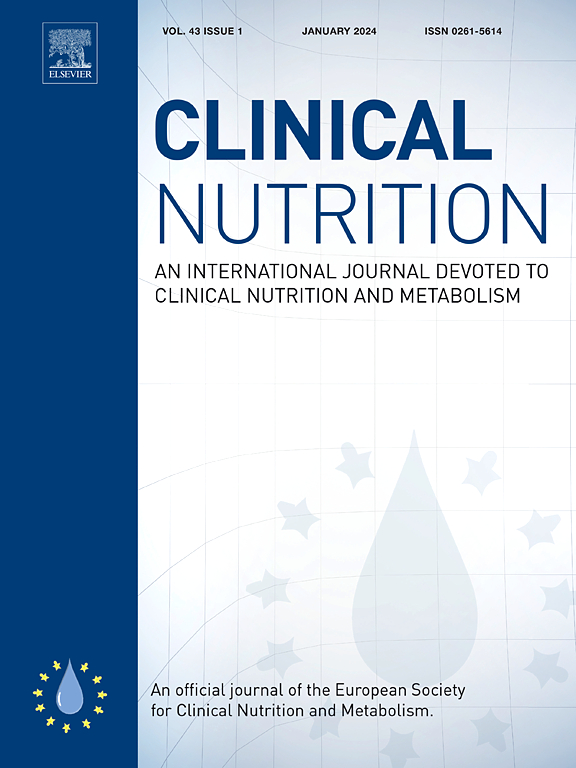Association between computed tomography-based adipose tissue parameters and liver transplant outcomes in patients with hepatocellular carcinoma
IF 7.4
2区 医学
Q1 NUTRITION & DIETETICS
引用次数: 0
Abstract
Background & aims
The prognostic value of skeletal muscle in liver transplant recipients with hepatocellular carcinoma (HCC) has been documented; however, the role of adipose tissue remains ambiguous. This study aimed to evaluate the association between adipose tissue and transplant outcomes in patients with HCC.
Methods
A total of 765 patients with HCC who underwent liver transplantation (LT) at 3 transplant centers were included in this retrospective study. Computed tomography (CT) scans were utilized to quantify the area and radiodensity of visceral and subcutaneous adipose tissue. Cut-off values for adipose tissue parameters were determined based on tertiles. The Cox proportional hazards models were established to identify the predictors of overall survival (OS) and tumor recurrence.
Results
Median age at transplant was 53 years, most were male (89.0 %) and cirrhotic (91.7 %). The median follow-up was 40.3 months. In univariate survival analysis, patients with high subcutaneous adipose tissue radiodensity (SATr) (>−86.5 HU) exhibited significantly lower 5-year OS rates than those with low SATr (49.9 % vs. 65.3 %, P < 0.001). Adjusted analyses revealed that high SATr independently predicted increased mortality (HR, 1.498; 95 % CI, 1.175–1.909; P = 0.001). SATr significantly increased during the first month postoperatively (P < 0.001), with one-third of the patients exhibiting an SATr change rate exceeding 10 %. An increase in SATr >10 % was independently associated with poorer OS (HR, 1.549; 95 % CI, 1.095–2.190; P = 0.013) and higher recurrence risk (HR, 1.776; 95 % CI, 1.242–2.540; P = 0.002).
Conclusion
Higher preoperative SATr was an independent predictor of patient mortality after LT for HCC. Postoperatively, a SATr increase >10 % during the first month was independently associated with elevated risk of mortality and tumor recurrence.
基于计算机断层扫描的脂肪组织参数与肝细胞癌患者肝移植结果之间的关系
背景,目的:研究骨骼肌在肝移植术后肝癌患者的预后价值;然而,脂肪组织的作用仍然不明确。本研究旨在评估肝细胞癌患者脂肪组织与移植结果之间的关系。方法回顾性分析在3个肝移植中心行肝移植的肝癌患者765例。利用计算机断层扫描(CT)来量化内脏和皮下脂肪组织的面积和放射密度。脂肪组织参数的截止值是基于tile确定的。建立Cox比例风险模型以确定总生存期(OS)和肿瘤复发的预测因子。结果移植时中位年龄为53岁,以男性(89.0%)和肝硬化(91.7%)为主。中位随访时间为40.3个月。在单因素生存分析中,高皮下脂肪组织放射密度(SATr) (> - 86.5 HU)患者的5年OS率明显低于低SATr患者(49.9% vs 65.3%, P <;0.001)。调整后的分析显示,高SATr独立预测死亡率增加(HR, 1.498;95% ci, 1.175-1.909;P = 0.001)。术后1个月内SATr显著升高(P <;0.001),三分之一的患者表现出超过10%的SATr变化率。SATr升高10%与较差的OS独立相关(HR, 1.549;95% ci, 1.095-2.190;P = 0.013)和较高的复发风险(HR, 1.776;95% ci, 1.242-2.540;P = 0.002)。结论术前较高的SATr是肝细胞癌肝移植后患者死亡率的独立预测因子。术后第一个月SATr升高10%与死亡率和肿瘤复发风险升高独立相关。
本文章由计算机程序翻译,如有差异,请以英文原文为准。
求助全文
约1分钟内获得全文
求助全文
来源期刊

Clinical nutrition
医学-营养学
CiteScore
14.10
自引率
6.30%
发文量
356
审稿时长
28 days
期刊介绍:
Clinical Nutrition, the official journal of ESPEN, The European Society for Clinical Nutrition and Metabolism, is an international journal providing essential scientific information on nutritional and metabolic care and the relationship between nutrition and disease both in the setting of basic science and clinical practice. Published bi-monthly, each issue combines original articles and reviews providing an invaluable reference for any specialist concerned with these fields.
 求助内容:
求助内容: 应助结果提醒方式:
应助结果提醒方式:


